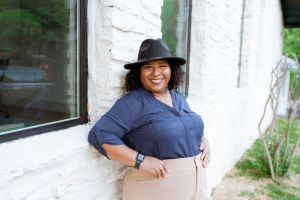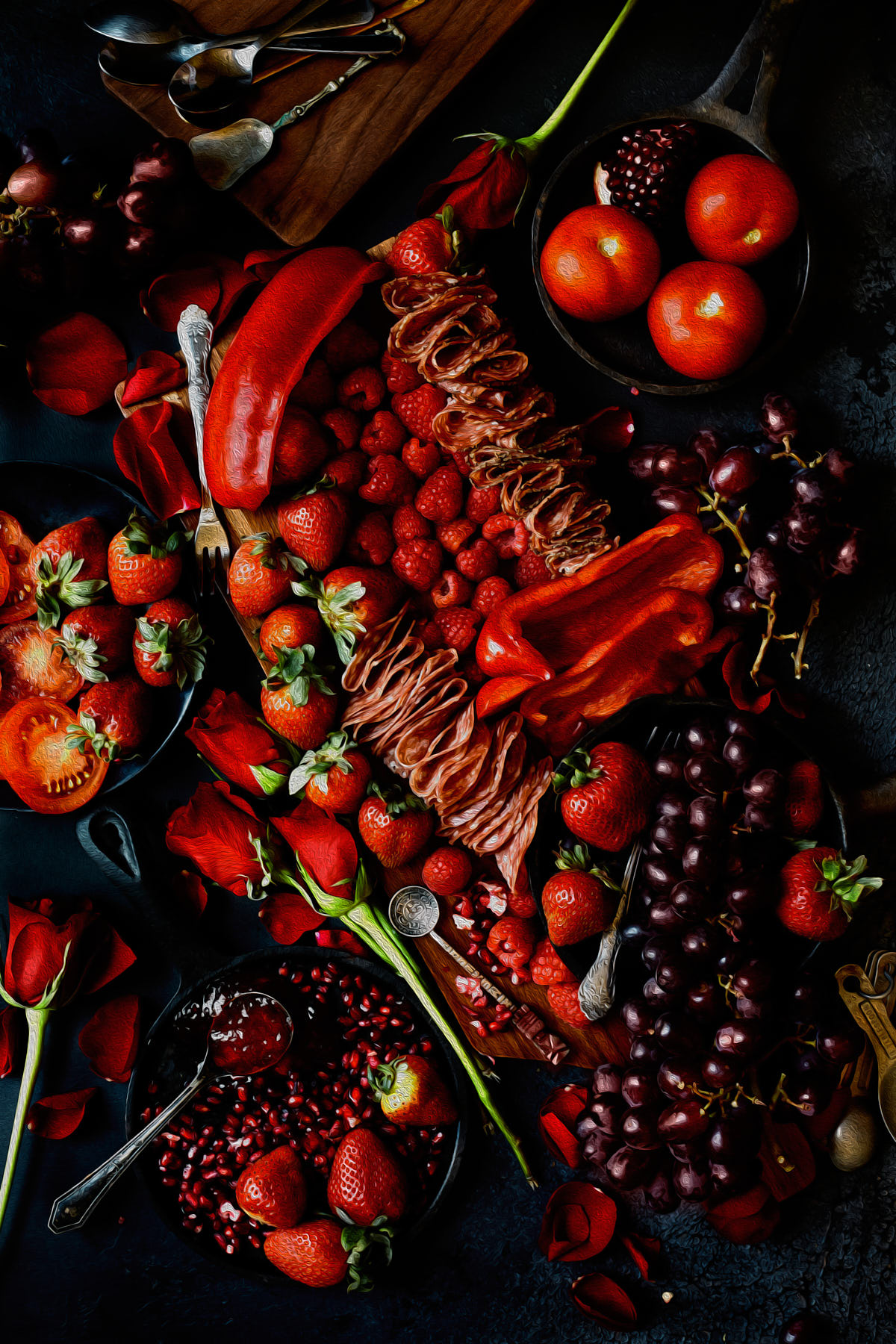1. Please introduce yourself. Who are you? What do you do? How long have you been into photography?
I’m Mica McCook, a food photographer based in Austin, Texas. I’ve been taking pictures professionally since 2015, but photography has been a constant presence throughout my life. My first visit to Reading Terminal in Philadelphia catapulted me into food photography. As soon as I stepped inside, I was swept up by the energy and the aroma wafting from each stall. It was all so moving. I knew right then that this was what I wanted to do with my life: capture the beauty and power of food.
2. In one sentence, please describe what you captured in this shot.
With this photo, I captured a beautiful charcuterie board featuring all red fruits, vegetables, and cured meats.
3. Why did you select this photo to share?
I selected this photo to share because it was the first image I ever shot that took my breath away. The dynamism, texture, and competing reds are an incredibly striking combination and perfectly showcase my style and love of saturated colors. This shot reminds me how far I’ve come as an artist, and I’m so proud to share it here.
4. When and where was this photo taken?
This food photo was taken midday in my home studio. I used window light and a whiteboard to reflect light onto the food. I used small black cards to create shadows.
5. When we met, you mentioned that food is a great way to get to know a city. Can you talk about that in relation to this photo?
What a great question! Food is a great way to get to know a city’s culture, history, and community. For example, Spain. Over the centuries, Spanish food has been influenced primarily by four cultures: Phoenicians, Greeks, Romans, and Arabs. There is a huge emphasis on freshness, regional dishes, and seafood and organic produce. Spanish food is a perfect combination of crunchy textures, vibrant colors, fresh fruits, and bold spices.
My husband and I visited Madrid in 2019 and ate our way through the city’s tapas, churros, paellas, and jamón. I was struck by how much their food tradition revolves around sharing community meals and eating outside.
This photo reminds me of my Spain trip because a charcuterie board is a communal meal and reflects the spirit of the city, where travelers and locals alike gather for good conversation and delicious food.
6. What equipment (hardware and software) did you use?
I shot with my Canon 5DS R and my Canon 50mm lens for this portrait. I edited this first in CaptureOne Pro using Mastin Labs presets and then in Photoshop.
7. Can you tell us more about what was going on behind the scenes when you took this photo? What was your setup? How many shots did it take to get one that you were satisfied with? Did you work with a food stylist?
This is a simple, straightforward setup. I shot an overhead angle with the camera resting on a tripod and the remote shutter release in my hand. I shot this in my home studio using diffused window light and black and white bounce cards. I believe in taking my time in prep so that we get the hero shot in less time. Since I shot in natural light, it didn’t take long to set my camera up.
Since I do a lot of prep work before a shoot, it doesn’t take me long to get the hero shot. For this particular shoot, it took three shots to get the hero shot, and for most portfolio shoots, I use that time to work on my food styling skills. For this shoot, I didn’t work with a food stylist.
8. Did you edit (or do any post-processing/production on) this photo?
Yes, I edited this photo. I did some basic cleanup in Capture One and applied a Mastin Labs preset. I’m a big fan of Mastin Labs presets because they help me get the look and feel that I love so much about film photography without having to deal with the hassle of using actual film. Finally, I cleaned it up in Photoshop.
9. Did you learn anything in the process of taking, editing, or sharing this photo? Was there any feedback or critique that you received during your photography journey that you applied to this photograph?
I learned to decrease hot spots in reflective fruits and vegetables like the tomatoes and grapes in this photo. A hot spot (also known as clipping or clipped highlights) is an area of your photo that is significantly brighter than other areas of your photo. The highlights appear overexposed or “blown out.”
The best feedback I received was in 2020 when I did a year-long mentorship with Bea Lubas, a world-renowned food photographer. We researched the connection between color theory and food photography and explored the elements that make an emotion an emotion. What makes a photo passionate? Thrilling? Is it hard light? Or the colors? Or the props? How can we bring all of these elements together to show emotion? How do these elements work together to make you feel something?
Exploring food photography from this point of view taught me to be very intentional with my shots and think about capturing moments, not just taking pictures. It taught me to think beyond taking a pretty picture of a pretty dish.
10. Do you remember what you had for breakfast the day you took this photo?
On the day I took this picture, I started off my morning with a protein-packed breakfast of Greek yogurt, blueberries, and granola. I rounded it out with two over-medium eggs.
11. What would you like people to take away from this photo?
What I want people to take away from this photo is the realization that they experienced an intense emotion, followed by a need to stop and think about why they felt that way and what it means. We all have an unconscious understanding of color’s psychological power, but we don’t often stop to think about how powerful an effect color has on us and our experiences.
12. When we chatted, you mentioned that you have done work in many styles of photography from portraits to fashion, and more. What made you gravitate towards food photography?
I think what I love most about food photography is that it’s an extension of my life. I get to share a part of myself with the audience through my work. I’ve always been passionate about storytelling, and I found that food was a great way to tell stories. It’s a great way to connect with a city, its culture, history, and community. I’m someone who has always been intrigued by the world around me, and when I was first starting out in photography and doing a lot of different kinds of work, from portraits to weddings, food just felt right. It kept me intrigued, and I picked it up pretty quickly.
Furthermore, it gave me an excuse to meet interesting people, like chefs, foodies, restaurant owners, and helped me get over my social anxiety by giving me something concrete and fun to talk about (unlike talking about myself).
13. What suggestions do you have for photographers that are in the beginning stages of sharing their work and seeking feedback on their photography?
The most important thing as a beginner is to ask questions. I’ve found that photographers who are willing to take criticism and feedback from others and to ask, “how can I make this a better photo?” are the ones who keep improving.
Another suggestion would be to reach out to a photographer whose work you admire and ask for feedback. Be sure to make it clear that you’re looking for constructive feedback on how you could improve and grow as a photographer.
And finally, if someone gives you constructive criticism, trust that they’re trying to be helpful, not hurtful. Don’t take it personally; constructive criticism is meant to help you grow!
14. Your TikTok shares so much of the process and technique behind your work. What inspires you to share from behind the scenes?
First, it’s never been my style to keep secrets. If someone asks me a question, I just want to give them a straight answer.
Second, I believe that sharing information helps everyone in the field progress. I know I wouldn’t be where I am today if it weren’t for the help and guidance from mentors and other photographers, so I feel like it’s my responsibility to pay it forward. Plus, people are genuinely curious about what goes on in a food photo shoot.
15. In June 2022, you’re launching a podcast called The Savory Shot, where you’ll have conversations around all things food and photography. What topics are you excited to dive into and how can readers stay in the know?
I am excited to dive into the business end of food photography. How do you book clients? How do you approach them? Who do you approach? What’s the best way to structure a portfolio, and how do you market your portfolio? There are so many resources for learning your craft, but very few for how to book clients.
I’m also excited about building a community of food photographers who can help each other grow and learn. The commercial photography industry is not tough to get into if you know who to reach, but it can be tough if you don’t have a network that can help guide you.
You can subscribe to the podcast on www.thesavoryshot.com or follow the @thesavoryshot on Instagram for updates and announcements.
16. For photographers making the leap towards working with clients and turning their passion into a profession, do you have any advice or words of wisdom?
I’d say, first and foremost, you need to recognize that this is your business. Treat your work like a business. Get a website, a professional email address, and a dedicated Instagram account. Work on your portfolio every quarter.
Consistent daily work will get you consistent daily gains. You don’t have to be perfect—in fact, if you wait until everything’s perfect before putting your work out there, you might never put it out there at all! Just get out there. Start small and build from there.
Oh, and, buy the book Running a Successful Photography Business, by Lisa Pritchard. The book is incredibly informative, and it’s written in an engaging, conversational style that makes it easy to read. And it has helped me so much!
About the Photographer 
Mica McCook (she/her/hers) is a food photographer and host of the bi-weekly show The Savory Shot. She has been taking pictures of food since 2015 and loves exploring color theory. Mica lives in Austin, Texas, with her husband Aaron and their dog Moxy. When she’s not behind the camera, you can find Mica dining out or going on a spontaneous road trip.
Editor’s Note
This interview with Mica McCook is part of a series with members of the Black Women Photographers community. If you’re feeling inspired and want to chat about your own food photography, join the discussion in Flickr Social.
